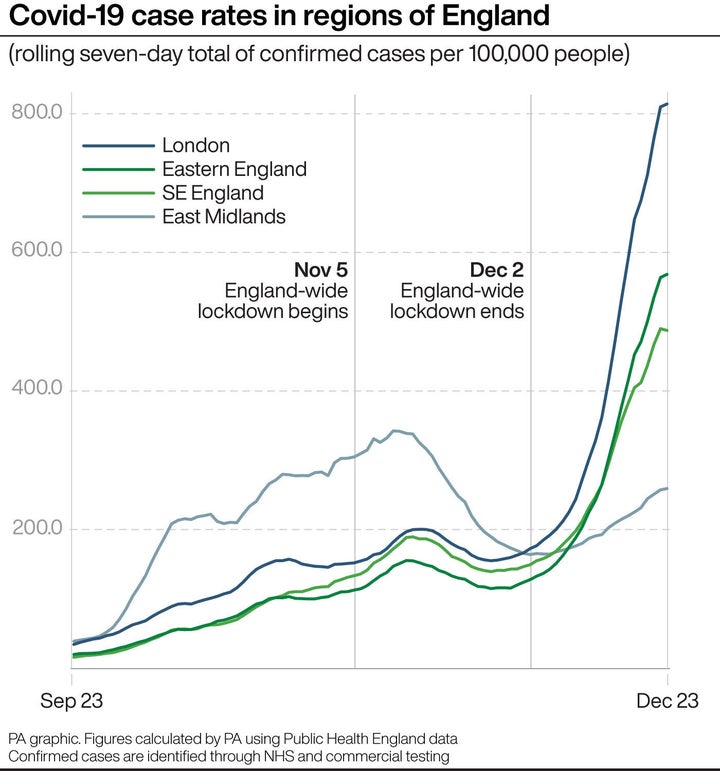With Covid-19 cases in the UK soaring, and hospitals under increasing pressure, questions have been raised over whether the harshest tier 4 lockdown restrictions are enough to curb the spread of the disease.
More than six million people in east and south east England went into tier 4 on Saturday, meaning 24m – 43% of the population – are now affected.
But more areas of England could be placed under tougher restrictions when the health secretary Matt Hancock outlines changes to tiers on Wednesday – a decision that will be made against a backdrop of rising infections and hospital admissions and a new more contagious variant in the UK that is believed to be up to 70% more contagious.
According to the Mirror, a Whitehall source has said the tier 4 rules do not appear to be working, adding that the government could introduce “another level on to tier 4, so like a tier 5”.
So could a new tier delay the reopening of schools after the Christmas break? And could parts of the country return to full lockdown status where leaving the house is limited to the bare essentials?
Which areas are set for tougher coronavirus restrictions?
With case rates rising in all regions of England, there are likely to be changes announced involving areas moving up a tier rather than down.
Five factors are considered when determining the restrictions in each area, including case detection rates in the over-60s, the rate at which cases are rising or falling and the ‘positivity rate’, which measures the number of positive cases detected as a percentage of tests taken. But the measures are not rigid as the government has said it needs to maintain flexibility to weigh the indicators against each other – such as whether hospital capacity in neighbouring areas is lower.
Reports suggest some parts of the East Midlands, such as Northamptonshire and Leicestershire, could be moved up from Tier 3 to Tier 4, while other counties such as Lincolnshire and Derbyshire may stay in Tier 3.
All the areas within the West Midlands metropolitan county – Birmingham, Coventry, Dudley, Sandwell, Solihull, Walsall and Wolverhampton – might be facing a move from Tier 3 to 4.
Hartlepool in north-east England, along with a handful of areas in Lancashire – Blackburn with Darwen, Burnley, Pendle and Ribble Valley – could also be upgraded from Tier 3 to 4.
Cumbria might be moved from Tier 2 to Tier 3, as could Worcestershire and North Yorkshire.

Lockdown measures are also in place across the other three home nations, after mainland Scotland entered tier 4 restrictions from Saturday for three weeks, and a similar stay-at-home order is in place in Wales.
Northern Ireland has also entered a new six-week lockdown, and the first-week measures are the toughest yet, with a form of curfew in operation from 8pm, shops closed from that time and all indoor and outdoor gatherings prohibited until 6am.
The head of an organisation representing health trusts said “as much of the country as possible” should go into the harshest tier 4.
Asked whether a national lockdown should be brought in, NHS Providers deputy chief executive Saffron Cordery told BBC Radio Five Live: “I think we need to see, yes, as much of the country as possible in tier 4.”
She said some trusts are reporting up to three times the number of Covid-19 patients as at the peak of the first wave.
Why is concern growing?
Key indicators are heading in the wrong direction. Figures from NHS England showed there were 21,787 patients in NHS hospitals in England as of 8am on Tuesday, compared with 20,426 on Monday, and 18,974 at the first wave peak on April 12.
The true number is likely to be even higher because figures do not include information from Scotland and Northern Ireland, which did not report data between December 24 and 28.
Trusts in England were told in a letter just before Christmas to begin planning for the use of Nightingale hospitals, although concerns have been raised around staffing the sites.
Five of the seven NHS regions in England are currently reporting a record number of Covid-19 hospital patients: Eastern England, London, the Midlands, south east England and south west England.
The other two regions, north east and north west England, remain below peak levels that were set in mid-November.
Total coronavirus cases hit a new record on Tuesday, rising above 50,000 cases for the first time, to 53,135 lab-confirmed cases.
While the number is likely to have been inflated by a delay in the reporting of data across the UK over Christmas – with some of the total including people who tested positive before December 25 – Dr Susan Hopkins said the figures are “largely a reflection of a real increase”.
The senior medical adviser for Public Health England, said the “unprecedented levels” of Covid-19 infection across the UK were of “extreme concern”.
It is not possible to make direct comparisons with the level of infection during the first wave of the virus, because mass testing was only introduced in the UK in May, but it has been estimated there may have been as many 100,000 cases a day at the peak in late March and early April.
But what about another, higher tier?
London – one of the first regions to be placed in tier 4 – is under particular pressure.
The number of Covid-19 patients in hospital in London is now higher than levels recorded at the peak of the first wave of the virus. A total of 5,371 hospital patients were confirmed as having Covid-19 as of 8am on December 29, according to the latest figures from NHS England. During the first wave, the number of patients in London peaked at 5,201 on April 9.
Paramedics in London are receiving support from other ambulance services in the south as they receive up to 8,000 emergency 999 calls each day.
Professor Andrew Hayward, of the government’s “new and emerging respiratory virus threats advisory group” (Nervtag), said widespread tier 4 restrictions – or even higher – are likely to be needed as the country moves towards “near-lockdown”.
He told BBC Radio 4’s Today programme: “I think we are entering a very dangerous new phase of the pandemic and we’re going to need decisive, early, national action to prevent a catastrophe in January and February.”
Fellow Nervtag member Professor Neil Ferguson said there had been a “balancing act” since lockdown was initially eased to try to keep control of the virus while maintaining “some semblance of normal society” but that the new variant had made it more difficult.
He told BBC Radio 4’s World At One programme: “Clearly nobody wants to keep schools shut. But if that’s the only alternative to having exponentially growing numbers of hospitalisations, that may be required at least for a period.”
What more could happen in ‘tier 5’?
Nobody knows for certain what a “tier 5” would entail, or whether tier 4 would be beefed up, if new measures were brought in by ministers. Given the limited room for more of a crackdown, “tier 5” could in effect become a regional version of the first national lockdown in the spring.
Under tier 4, pubs, bars and restaurants are still allowed to operate as a takeaways. During the spring lockdown they were shut entirely, leaving open only essential shops including supermarkets and pharmacies.
Tier 4 prohibits mixing indoors with anyone outside your household or support bubble – but you can meet one person outside in a public place such as a park. The national lockdown barred this from happening.
The earlier lockdown from March to May saw schools closed for the majority of pupils, and other restrictions included the order to venture outside only once a day for exercise, leave home only for essentials, and for all non-essential shops and places of worship to close.

